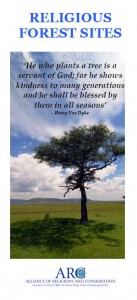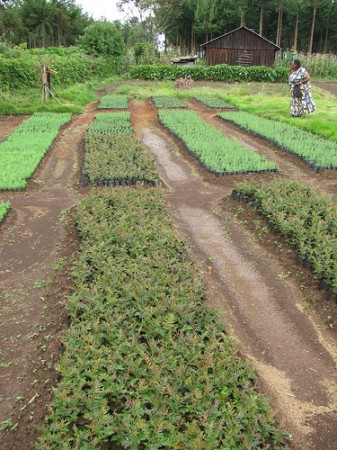 A short piece in The Times of India 1 pointed me to a longer version of basically the same press release on an interesting project to map the sacred forests of the world. This is a collaboration between the Oxford Biodiversity Institute and the Alliance for Religion and Conservation (ARC), the latter of which is new to me. Worth keeping an eye on. Unfortunately none of the players involved seem to have heard of RSS.
A short piece in The Times of India 1 pointed me to a longer version of basically the same press release on an interesting project to map the sacred forests of the world. This is a collaboration between the Oxford Biodiversity Institute and the Alliance for Religion and Conservation (ARC), the latter of which is new to me. Worth keeping an eye on. Unfortunately none of the players involved seem to have heard of RSS.
Nibbles: Heat, Watermelons, Rye, Apples, Solanum melongena, Pinus edulis, Food systems, Indian rice, Glycene
- Heat takes growing toll on Kansas farm crops. Heat, not drought. Just sayin’.
- Amateur Hour I: watermelons.
- Amateur Hour II: perennial rye.
- Amateur Hour III: red-fleshed apples.
- Bronjenas. An eggplant by any other name is still an aubergine (Solanum melongena).
- Not your average pinoli.
- We need to fix the food system. But how? Answers on a postcard, please.
- Saving traditional rice landraces in India. Of which there are maybe 3,000 in the NE alone. No mention of genebanks.
- Superstar Swedish soybeans
Nibbles: Frogs, Sacred forests, Heirloom onions, Lobster, Przewalski’s horses, Marco Polo sheep
- Eating frog legs is bad. France surrenders.
- Oxford boffins to map world’s sacred forests.
- Lafort onion: from the Wellesbourne genebank to Irish Seed Savers to urban kitchen garden.
- Lobster 101.
- A wild relative in trouble any way you slice it.
- And one that gets around. Didn’t we blog about this before? Yep.
The pros and cons of genetic pollution
![]() Is genetic pollution necessarily a bad thing? Well of course there’s pollution and pollution, and the term is often used to describe what might happen to a crop or its wild relatives when a GM variety of that crop starts to be grown in their proximity. But here I mean the genetic mixing of two previously isolated plant populations. As could happen, for example, when you regenerate two genebank accessions of an outcrossing crop side by side. Or when you cultivate an exotic variety of an agroforestry species near wild stands of the same species. Or when you use seed of a wild species from point A to help restore its numbers at far-away point B. The debate about whether genetic mixing is a good or bad thing for conservation has been going on for a while, of course. It is generally thought to be bad. But by coincidence three papers came across my desk this week which suggest that we should perhaps keep an open mind.
Is genetic pollution necessarily a bad thing? Well of course there’s pollution and pollution, and the term is often used to describe what might happen to a crop or its wild relatives when a GM variety of that crop starts to be grown in their proximity. But here I mean the genetic mixing of two previously isolated plant populations. As could happen, for example, when you regenerate two genebank accessions of an outcrossing crop side by side. Or when you cultivate an exotic variety of an agroforestry species near wild stands of the same species. Or when you use seed of a wild species from point A to help restore its numbers at far-away point B. The debate about whether genetic mixing is a good or bad thing for conservation has been going on for a while, of course. It is generally thought to be bad. But by coincidence three papers came across my desk this week which suggest that we should perhaps keep an open mind.
The first paper looks at an annual plant in California, Mimulus laciniatus. 2 The researchers compared the progenies of different kinds of crosses in a common garden experiment to measure their overall fitness. They crossed plants from populations at the centre and at the warm periphery of the distribution of the species in various combinations. The most successful crosses, in terms of lifetime reproductive success, were between plants that came from different edge populations. So in this case, a little bit of pollution is actually a pretty good thing, if it comes from the right place.
The second paper looks at a long-lived woody shrub in Australia, Telopea speciosissima. 3 There’s a lot of different aspects to the study, but let me focus on just one. The species is found along an altitudinal transect. There is considerable genetic structure along this transect, and a close association between altitude, temperature and flowering time. Altitude influences flowering phenology, differences in which throw up a temporal reproductive barrier between coastal and upland populations, leading to genetic differentiation. But not as much as formerly. The current temperature gradient is much flatter than it used to be at glacial maximum, and this has led to phenological overlap and genetic mixing at intermediate altitudes. What’s happening is a natural version of the centre x edge crosses done artificially in the previous paper. The fitness result? The authors are not sure. Could be good, could be bad. They’re going to set up the experiments to find out.
And finally we have a paper on the use of natural hybrids in forest restoration. 4 This really ups the ante. We’re no longer talking about the kinds of intra-specific hybrids found at the admixture front at mid-altitudes in the previous paper, or the progenies of the artificial crosses between populations made in the first. We’re talking about hybrids between related tree species. Genetic pollution squared. The authors point out that “restoration programs rarely use local hybrid individuals if a local species exhibits natural hybridization.” But they think they should.
…our current research based on ecophysiological measures of water-use efficiency under controlled conditions on seedlings from these populations suggest that hybrids deal with drier conditions better than either parental species, a trait that could be important for climate change adaptation.
So, should we be a bit more relaxed about genetic pollution? The debate can only intensify as the need for species and habitat restoration, and perhaps assisted migration, increases with climate change. Perhaps we should start by choosing a less value-laden term for it.
Gender inequity in agroforestry seed supply
 You may remember that in
You may remember that in last this week’s Brainfood we linked to a paper which looked at agroforestry input supply systems, and recommended a commercial, decentralized model for getting high quality tree seeds to smallholders. Now I’ve come across “Gender and agroforestry in Africa: a review of women’s participation.” The bottom line — not surprisingly, alas — is that women’s participation tends to be lower in enterprises in which there’s more money at stake. But this second paper only looked at the outputs, not the inputs. It would be interesting to know whether women tend to be edged out of commercial tree seed supply enterprises too. I suspect they do, which suggests that following the recommendation of the first paper for tree seed supply systems might result in even more pronounced gender inequity. So what could be done about it? Both papers include ICRAF staff as co-authors, though there’s no overlap. Maybe some of them have already thought about this and might like to comment here.